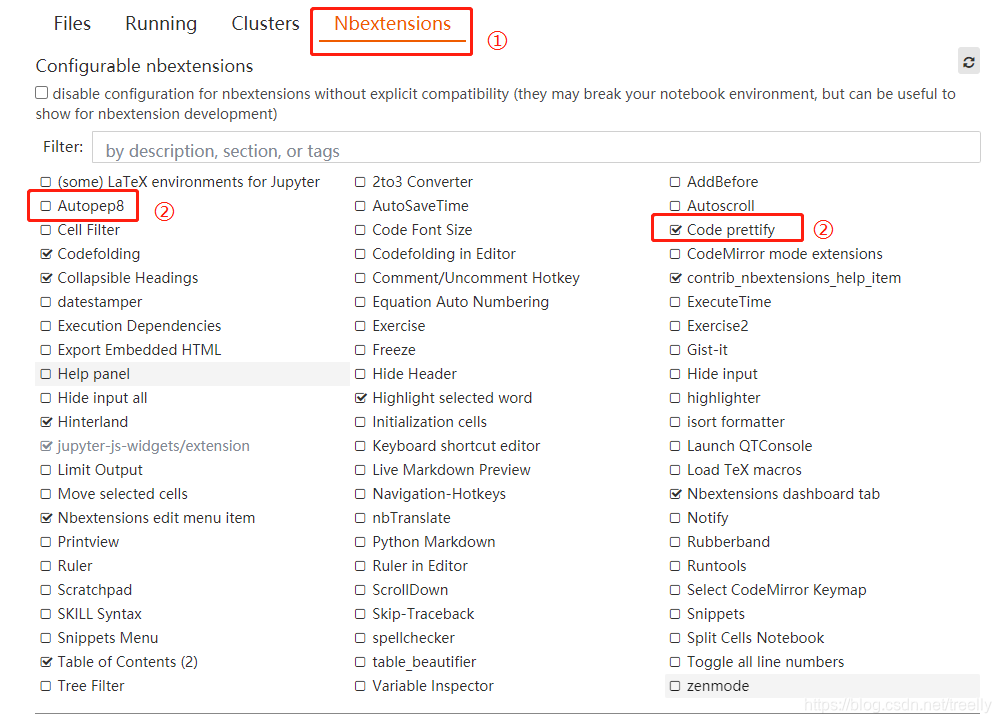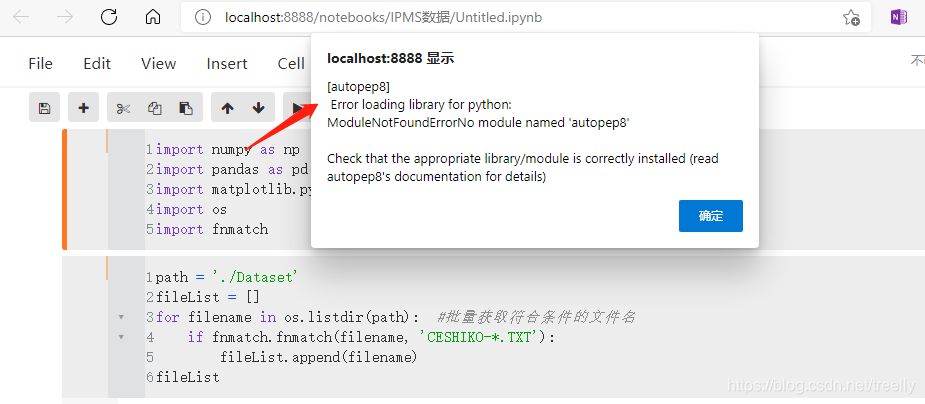图片插入
Markdown 语法插入图片(最简单的方式:复制图片,粘贴)

HTML 语法插入图片,可以设置图片
<img width='700px' src="URL">
<div style="color: #888; font-size: 10px; text-align: right;"><a href="URL"><i class="fa fa-copyright" aria-hidden="true"> 来源</i></a></div>
代码格式化
-
点击jupyter notebook——Nbextensions项,勾选Autopep8或者Code prettify。

-
刷新项目页面,弹出错误提示:缺少autopep8 或者yapf模块,需要安装对应模块。
(大多数 Python 代码格式化工具(比如:autopep8 和 pep8ify)是可以移除代码中的 lint 错误,具有局限性。比如:遵循 PEP 8 指导的代码可能就不会被格式化了,但这并不说明代码看起来就舒服。yapf把初始代码重新编排,即便初始代码并没有违背规范,也可使其达到遵循代码规范的最佳格式。这个理念和 Go 语言中的 gofmt 工具相似。)

-
在命令行安装:pip install autopep8 或者 pip install yapf
-
再次回到项目界面,选中需要格式化的cell,点击工具栏右边的小锤子就可以实现代码格式化了!(全选:按住shift 键)

python代码规范
之前学习python做练习的时候,没有注意过代码规范问题。今天浏览了一下Python 编码规范(Google),才发现以前写的代码都长在了错误点了。在这里把容易出错的点整理一下,以便查阅。(来源于Python 编码规范(Google),自己学习使用,侵删)。

格式
行长度
每行不超过80个字符,以下情况除外:
- 长的导入模块语句
- 注释里的URL
不要使用反斜杠连接行。
Python会将 圆括号, 中括号和花括号中的行隐式的连接起来 , 你可以利用这个特点. 如果需要, 你可以在表达式外围增加一对额外的圆括号。
推荐: foo_bar(self, width, height, color='black', design=None, x='foo',
emphasis=None, highlight=0)
if (width == 0 and height == 0 and
color == 'red' and emphasis == 'strong'):
如果一个文本字符串在一行放不下, 可以使用圆括号来实现隐式行连接:
x = ('这是一个非常长非常长非常长非常长 '
'非常长非常长非常长非常长非常长非常长的字符串')
在注释中,如果必要,将长的URL放在一行上。
Yes: # See details at
# http://www.example.com/us/developer/documentation/api/content/v2.0/csv_file_name_extension_full_specification.html
No: # See details at
# http://www.example.com/us/developer/documentation/api/content/\
# v2.0/csv_file_name_extension_full_specification.html
括号
宁缺毋滥的使用括号。除非是用于实现行连接, 否则不要在返回语句或条件语句中使用括号. 不过在元组两边使用括号是可以的。
Yes: if foo:
bar()
while x:
x = bar()
if x and y:
bar()
if not x:
bar()
return foo
for (x, y) in dict.items(): ...
No: if (x):
bar()
if not(x):
bar()
return (foo)
缩进
用4个空格来缩进代码 。绝对不要用tab, 也不要tab和空格混用 (不明白为什么不能用tab??) . 对于行连接的情况, 你应该要么垂直对齐换行的元素, 或者使用4空格的悬挂式缩进(这时第一行不应该有参数):
Yes: # 与起始变量对齐
foo = long_function_name(var_one, var_two,
var_three, var_four)
# 字典中与起始值对齐
foo = {
long_dictionary_key: value1 +
value2,
...
}
# 4 个空格缩进,第一行不需要
foo = long_function_name(
var_one, var_two, var_three,
var_four)
# 字典中 4 个空格缩进
foo = {
long_dictionary_key:
long_dictionary_value,
...
}
No: # 第一行有空格是禁止的
foo = long_function_name(var_one, var_two,
var_three, var_four)
# 2 个空格是禁止的
foo = long_function_name(
var_one, var_two, var_three,
var_four)
# 字典中没有处理缩进
foo = {
long_dictionary_key:
long_dictionary_value,
...
}
空行
顶级定义之间空两行, 比如函数或者类定义. 方法定义, 类定义与第一个方法之间, 都应该空一行. 函数或方法中, 某些地方要是你觉得合适, 就空一行.
空格
不要在逗号, 分号, 冒号前面加空格, 但应该在它们后面加(除了在行尾).
Yes: if x == 4:
print x, y
x, y = y, x
No: if x == 4 :
print x , y
x , y = y , x
在二元操作符两边都加上一个空格, 比如赋值(=), 比较(==, <, >, !=, <>, <=, >=, in, not in, is, is not), 布尔(and, or, not). 至于算术操作符两边的空格该如何使用, 需要你自己好好判断. 不过两侧务必要保持一致.
Yes: x == 1
No: x<1
当'='用于指示关键字参数或默认参数值时, 不要在其两侧使用空格.
Yes: def complex(real, imag=0.0): return magic(r=real, i=imag)
No: def complex(real, imag = 0.0): return magic(r = real, i = imag)
不要用空格来垂直对齐多行间的标记, 因为这会成为维护的负担(适用于:, #, =等):
Yes:
foo = 1000 # 注释
long_name = 2 # 注释不需要对齐
dictionary = {
"foo": 1,
"long_name": 2,
}
No:
foo = 1000 # 注释
long_name = 2 # 注释不需要对齐
dictionary = {
"foo" : 1,
"long_name": 2,
}
语句
通常每个语句应该独占一行
不过, 如果测试结果与测试语句在一行放得下, 你也可以将它们放在同一行. 如果是if语句, 只有在没有else时才能这样做. 特别地, 绝不要对 try/except 这样做, 因为try和except不能放在同一行.
Yes:
if foo: bar(foo)
No:
if foo: bar(foo)
else: baz(foo)
try: bar(foo)
except ValueError: baz(foo)
try:
bar(foo)
except ValueError: baz(foo)
???上方错误的地方是except行没有换行吗?
尾随逗号(Trailing commas)
Trailing commas in sequences of items are recommended only when the closing container token ], ), or } does not appear on the same line as the final element.
Yes: golomb3 = [0, 1, 3]
Yes: golomb4 = [
0,
1,
4,
6,
]
No: golomb4 = [
0,
1,
4,
6
]
注释
文档字符串
Python有一种独一无二的的注释方式: 使用文档字符串. 文档字符串是包, 模块, 类或函数里的第一个语句. 这些字符串可以通过对象的__doc__成员被自动提取, 并且被pydoc所用. 我们对文档字符串的惯例是使用三重双引号"""( PEP-257 ). 一个文档字符串应该这样组织: 首先是一行以句号,问号或惊叹号结尾的概述(或者该文档字符串单纯只有一行). 接着是一个空行. 接着是文档字符串剩下的部分,它应该与文档字符串的第一行的第一个引号对齐. 下面有更多文档字符串的格式化规范.
模块
每个文件应该包含一个许可样板. 根据项目使用的许可(例如, Apache 2.0, BSD, LGPL, GPL), 选择合适的样板.
函数和方法
下文所指的函数,包括函数, 方法, 以及生成器. 一个函数必须要有文档字符串, 除非它满足以下条件:
- 外部不可见
- 非常短小
- 简单明了
文档字符串应该包含函数做什么, 以及输入和输出的详细描述. 通常, 不应该描述"怎么做", 除非是一些复杂的算法. 文档字符串应该提供足够的信息, 当别人编写代码调用该函数时, 他不需要看一行代码, 只要看文档字符串就可以了. 对于复杂的代码, 在代码旁边加注释会比使用文档字符串更有意义.
关于函数的几个方面应该在特定的小节中进行描述记录, 这几个方面如下文所述. 每节应该以一个标题行开始. 标题行以冒号结尾. 除标题行外, 节的其他内容应被缩进2个空格.
Args: 列出每个参数的名字, 并在名字后使用一个冒号和一个空格, 分隔对该参数的描述.如果描述太长超过了单行80字符,使用2或者4个空格的悬挂缩进(与文件其他部分保持一致). 描述应该包括所需的类型和含义. 如果一个函数接受foo(可变长度参数列表)或者**bar (任意关键字参数), 应该详细列出foo和**bar. Returns: (或者 Yields: 用于生成器) 描述返回值的类型和语义. 如果函数返回None, 这一部分可以省略. Raises: 列出与接口有关的所有异常.
def fetch_bigtable_rows(big_table, keys, other_silly_variable=None):
"""Fetches rows from a Bigtable.
Retrieves rows pertaining to the given keys from the Table instance
represented by big_table. Silly things may happen if
other_silly_variable is not None.
Args:
big_table: An open Bigtable Table instance.
keys: A sequence of strings representing the key of each table row
to fetch.
other_silly_variable: Another optional variable, that has a much
longer name than the other args, and which does nothing.
Returns:
A dict mapping keys to the corresponding table row data
fetched. Each row is represented as a tuple of strings. For
example:
{'Serak': ('Rigel VII', 'Preparer'),
'Zim': ('Irk', 'Invader'),
'Lrrr': ('Omicron Persei 8', 'Emperor')}
If a key from the keys argument is missing from the dictionary,
then that row was not found in the table.
Raises:
IOError: An error occurred accessing the bigtable.Table object.
"""
pass
类
类应该在其定义下有一个用于描述该类的文档字符串. 如果你的类有公共属性(Attributes), 那么文档中应该有一个属性(Attributes)段. 并且应该遵守和函数参数相同的格式.
class SampleClass(object):
"""Summary of class here.
Longer class information....
Longer class information....
Attributes:
likes_spam: A boolean indicating if we like SPAM or not.
eggs: An integer count of the eggs we have laid.
"""
def __init__(self, likes_spam=False):
"""Inits SampleClass with blah."""
self.likes_spam = likes_spam
self.eggs = 0
def public_method(self):
"""Performs operation blah."""
块注释和行注释
最需要写注释的是代码中那些技巧性的部分. 如果你在下次 代码审查 的时候必须解释一下, 那么你应该现在就给它写注释. 对于复杂的操作, 应该在其操作开始前写上若干行注释. 对于不是一目了然的代码, 应在其行尾添加注释.
# We use a weighted dictionary search to find out where i is in
# the array. We extrapolate position based on the largest num
# in the array and the array size and then do binary search to
# get the exact number.
if i & (i-1) == 0: # true iff i is a power of 2
为了提高可读性, 注释应该至少离开代码2个空格.
类型注释
类型注释(或“类型提示”)用于函数或方法参数和返回值:
Yes:
def func(a: int) -> List[int]:
def func(a: int = 0) -> int:
...
No:
def func(a:int=0) -> int:
...
TODO注释
为临时代码使用TODO注释, 它是一种短期解决方案. 不算完美, 但够好了.
TODO注释应该在所有开头处包含"TODO"字符串, 紧跟着是用括号括起来的你的名字, email地址或其它标识符. 然后是一个可选的冒号. 接着必须有一行注释, 解释要做什么. 主要目的是为了有一个统一的TODO格式, 这样添加注释的人就可以搜索到(并可以按需提供更多细节). 写了TODO注释并不保证写的人会亲自解决问题. 当你写了一个TODO, 请注上你的名字.
# TODO(kl@gmail.com): Use a "*" here for string repetition.
# TODO(Zeke) Change this to use relations.
如果你的TODO是"将来做某事"的形式, 那么请确保你包含了一个指定的日期("2009年11月解决")或者一个特定的事件("等到所有的客户都可以处理XML请求就移除这些代码").
命名
Python之父Guido推荐的规范
| Type | Public | Internal |
|---|---|---|
| Modules | lower_with_under | _lower_with_under |
| Packages | lower_with_under | |
| Classes | CapWords | _CapWords |
| Except | CapWords | |
| Functions | lower_with_under() | _lower_with_under() |
| Global/Class | Constants CAPS_WITH_UNDER | _CAPS_WITH_UNDER |
| Global/Class Variables | lower_with_under | _lower_with_under |
| Instance Variables | lower_with_under | _lower_with_under (protected) or __lower_with_under (private) |
| Method Names | lower_with_under() | _lower_with_under() (protected) or __lower_with_under() (private) |
| Function/Method Parameters | lower_with_under | |
| Local Variables | lower_with_under |
应该避免的名称
- 单字符名称, 除了计数器和迭代器.
- 包/模块名中的连字符(-)
- 双下划线开头并结尾的名称(Python保留, 例如__init__)
命名约定
- 所谓"内部(Internal)"表示仅模块内可用, 或者, 在类内是保护或私有的.
- 用单下划线(_)开头表示模块变量或函数是protected的(使用import * from时不会包含).
- 用双下划线(__)开头的实例变量或方法表示类内私有.
- 将相关的类和顶级函数放在同一个模块里. 不像Java, 没必要限制一个类一个模块.
- 对类名使用大写字母开头的单词(如CapWords, 即Pascal风格),但是模块名应该用小写加下划线的方式(如lower_with_under.py).
尽管已经有很多现存的模块使用类似于CapWords.py这样的命名, 但现在已经不鼓励这样做, 因为如果模块名碰巧和类名一致,这会让人困扰.
导入
导入类和函数时,在首次使用的单元格中导入,而不是在 Notebook 一开始集中一次性导入。前者为 Jupyter Notebook 推荐书写方式,后者为本地 IDE 代码中推荐书写方式。
Main函数
即使是一个打算被用作脚本的文件, 也应该是可导入的. 并且简单的导入不应该导致这个脚本的主功能(main functionality)被执行, 这是一种副作用. 主功能应该放在一个main()函数中.
在Python中, pydoc以及单元测试要求模块必须是可导入的. 你的代码应该在执行主程序前总是检查 if __name__ == '__main__' , 这样当模块被导入时主程序就不会被执行.
def main():
...
```python
if __name__ == '__main__':
main()
类
如果一个类不继承自其它类, 就显式的从object继承. 嵌套类也一样.
继承自 object 是为了使属性(properties)正常工作, 并且这样可以保护你的代码, 使其不受Python 3000的一个特殊的潜在不兼容性影响. 这样做也定义了一些特殊的方法, 这些方法实现了对象的默认语义, 包括 __new__, __init__, __delattr__, __getattribute__, __setattr__, __hash__, __repr__, and __str__ .
Yes: class SampleClass(object):
pass
class OuterClass(object):
class InnerClass(object):
pass
class ChildClass(ParentClass):
"""Explicitly inherits from another class already."""
No: class SampleClass:
pass
class OuterClass:
class InnerClass:
pass
字符串
Yes: x = a + b
x = '%s, %s!' % (imperative, expletive)
x = '{}, {}!'.format(imperative, expletive)
x = 'name: %s; score: %d' % (name, n)
x = 'name: {}; score: {}'.format(name, n)
No: x = '%s%s' % (a, b) # use + in this case
x = '{}{}'.format(a, b) # use + in this case
x = imperative + ', ' + expletive + '!'
x = 'name: ' + name + '; score: ' + str(n)
避免在循环中用+和+=操作符来累加字符串. 由于字符串是不可变的, 这样做会创建不必要的临时对象, 并且导致二次方而不是线性的运行时间. 作为替代方案, 你可以将每个子串加入列表, 然后在循环结束后用 .join 连接列表. (也可以将每个子串写入一个 cStringIO.StringIO 缓存中.)
Yes: items = ['<table>']
for last_name, first_name in employee_list:
items.append('<tr><td>%s, %s</td></tr>' % (last_name, first_name))
items.append('</table>')
employee_table = ''.join(items)
No: employee_table = '<table>'
for last_name, first_name in employee_list:
employee_table += '<tr><td>%s, %s</td></tr>' % (last_name, first_name)
employee_table += '</table>'
在同一个文件中, 保持使用字符串引号的一致性. 使用单引号’或者双引号"之一用以引用字符串, 并在同一文件中沿用. 在字符串内可以使用另外一种引号, 以避免在字符串中使用. PyLint已经加入了这一检查.
Yes:
Python('Why are you hiding your eyes?')
Gollum("I'm scared of lint errors.")
Narrator('"Good!" thought a happy Python reviewer.')
No:
Python("Why are you hiding your eyes?")
Gollum('The lint. It burns. It burns us.')
Gollum("Always the great lint. Watching. Watching.")
为多行字符串使用三重双引号"""而非三重单引号'''. 当且仅当项目中使用单引号’来引用字符串时, 才可能会使用三重’’'为非文档字符串的多行字符串来标识引用. 文档字符串必须使用三重双引号""". 不过要注意, 通常用隐式行连接更清晰, 因为多行字符串与程序其他部分的缩进方式不一致.
Yes:
print ("This is much nicer.\n"
"Do it this way.\n")
No:
print """This is pretty ugly.
Don't do this.
"""
文件
推荐使用 "with"语句 以管理文件:
with open("hello.txt") as hello_file:
for line in hello_file:
print line
对于不支持使用"with"语句的类似文件的对象,使用 contextlib.closing():
import contextlib
with contextlib.closing(urllib.urlopen("http://www.python.org/")) as front_page:
for line in front_page:
print line
真/假判定
定义
在布尔上下文中,Python 将某些值评估为 False。一个“经验法则”是所有“空”值都被认为是假的,所以 0、无、[]、{}、’’ 在布尔上下文中都被判定为假。
使用方法
如果可能,使用“隐式”false,例如,if foo: 而不是 if foo != []:。不过,应该记住一些注意事项:
- 始终使用
if foo is None:(or is not None)来检查 None 值。 - 切勿使用
==将布尔变量与 False 进行比较,使用if not x:。如果您需要区分 False 和 None ,if not x and x is not None: - 对于序列(字符串、列表、元组),对于空序列为假的事实,使用
if seq: 和 if not seq:比if len(seq): 和 if not len(seq):更可取。 - 将已知为整数(并且不是
len()的结果)的值与整数 0 进行比较。 - 请注意,
“0”(即 0 作为字符串)的判定结果为真。
Yes: if not users:
print('no users')
if foo == 0:
self.handle_zero()
if i % 10 == 0:
self.handle_multiple_of_ten()
def f(x=None):
if x is None:
x = []
No: if len(users) == 0:
print('no users')
if foo is not None and not foo:
self.handle_zero()
if not i % 10:
self.handle_multiple_of_ten()
def f(x=None):
x = x or []





















 683
683











 被折叠的 条评论
为什么被折叠?
被折叠的 条评论
为什么被折叠?








